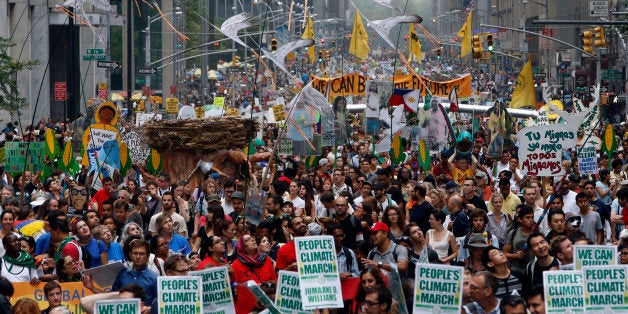
Don't call it a "march." It was a "stand" -- and a first stand at that, not a last one. The People's Climate March, billed as the largest climate demonstration in history, more than exceeded expectations and was an experience that has yet to desert me. Its moment couldn't have been grimmer in global warming terms. That week, record-breaking concentrations of greenhouse gases were reported in the atmosphere, with the added grim news that the oceans and the forests, the planet's major "carbon sinks," were starting to absorb less CO2. Under the circumstances, I had the urge to do my bit to make the march huge and so organized a group of 16 friends and family members, ranging in age from 2 to 72. Marchers were to gather on New York's Central Park West between 86th Street and Columbus Circle at 59th, where the event was to kick off at exactly 11:30 a.m. At 11, when our crew arrived at 72nd Street, designated as a meeting place for children, families, and oldsters like me, the main route along Central Park West was already jam-packed and feeder streets like ours were filling fast.
On our small, ever-tighter stretch of cement was a typically heterogeneous crew sporting small dogs, a large penguin doll, a gazillion handmade signs, and a strutting, dancing drum-and-cymbal band. Amid cheers, music, and conversation, time passed and passed and passed. Though those younger than me were getting texts indicating that the march had set off in a timely manner, we didn't move. Not an inch. And then it began to dawn on me. This demonstration was going to be so big, with so many people feeding into it, that "marching" for many of us would be an alien activity. As Todd Gitlin makes thrillingly clear today in "A Change in the Climate," we were quite literally in the midst of a genuine movement being born. In fact, our crew, only 13 blocks north of the starting spot, didn't even inch forward for more than an hour and a half after the official launch.
That's what it turns out to mean to have 400,000 people crammed into a New York mile and cordoned off by the police (who control the streets, effectively imprisoning crowds). By the time I reached the official beginning of the march at 59th Street, three and a half hours after we arrived, my legs were goners. So, for another half an hour, I stopped with a friend, Peter Dimock, and watched the march pass in all its strange splendor and remarkable youthfulness, a kaleidoscope of floats and signs and costumes and performances spilling by, and still I couldn't see the end of it. It's the only demonstration I've ever attended where, officially speaking, I never began -- and that represents a triumph of organizing and evidence of a growing concern for the state and fate of our planet.
Peter spent much of the march scribbling down what was on the panoply of signs around us, almost all made by individuals to express some urge about our degrading world, so many that his list of hundreds could make a dispatch in itself. And yet he caught only a small fraction of the march's signs. Here are just a few of those to give you a taste of what may, as Gitlin suggests, have been a defining moment of hope in an otherwise grim era:
"Being Cool Has Never Been So Hot," "Another Grandmother for Climate Justice," "Our Planet is Not Something You Can Negotiate," "I'm Sure the Dinosaurs Thought They Had Time, Too," "Frack Off: Indigenous Women Leaders Leading Media Campaign to Defend Our Planet," "Tax CO2," "The Answer, My Friend, Is Blowing in the Wind" (with an image of a wind turbine), "Even Princeton" (sign held by one of a group of Princeton engineering and technology students marching together), "Don't Panic, Learn to Swim," "Evolve or Dissolve," "Infinite Economic Growth (crossed out), Finite Planet," "'Natural Gas' Is Not the Answer," "There is No Planet B," "I'm Marching for the Only Habitable Place in the Universe," "Wall Street, Your Kingdom Must Come Down," "Save the Snowmen," "We Did Not Inherit the Earth from Our Ancestors. We Borrowed It From Our Grandchildren."
